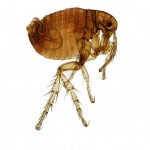Take this quick quiz to find out just how much you DON’T know about fleas and your pets!
1. There is one species of flea.
FALSE
One of the many Wonders of the Bug World, the flea has 2,000 species worldwide and 300 species in North America.
2. The domestic cat flea species is also found on dogs.
TRUE
The scientific name for this species is Ctenocephalides felis. This species of flea selects dogs, cats, and humans as its preferred hosts.
3. Fleas are becoming immune to our Flea collars and treatments.
FALSE
Dr. Mike Dryden, of Kansas State Veterinary Medicine, did a study on apparent failure of flea products. He visited 1,000 homes in the Tampa, Florida area, all of whom said that they were using preventative appropriately. In all of those homes he found no real evidence of flea resistance, and in all but one or two found that the client had the wrong understanding of fleas and how the products work or weren’t using them properly. There is little to no evidence of any sort that fleas have developed any resistance to products released in the last few years, and these products are actually very effective.
4. Fleas lay 100’s or 1,000’s of eggs each day
FALSE
Fleas lay between 30-40 eggs each day.
5. Fleas infest, grow, and live on your pets.
FALSE
Fleas enter the house on one of your furry-footed pets, but then they make a home in the carpets, bedding, pet beds, and upholstered furniture. There the flea eggs grow to larvae, then adults and hop on your pet again
6. In winter, pet owners don’t need to worry about fleas.
FALSE
Although you may not see them in the winter in cold climates, fleas can live quite comfortably in your house, as well as on wildlife. If your pet or your house had fleas during the warm months, you’re likely to have fleas during the winter months as well. If your pet goes outdoors and may have contact with squirrels, birds, or other wildlife, they can still get fleas. And, of course, fleas live happily in warm climates all year long, so flea control is a year-round battle.
7. Fleas hatch from eggs, then still have to go through a larval stage, before they are adults and bite your pet.
TRUE
Adult fleas are only 5% of the flea population. If you’re not treating your house and yard, you’re missing the eggs, larvae, and cocoons, which account for the other 95 percent.
Don’t underestimate this external parasite, the common flea reigns supreme during North Carolina summers!












